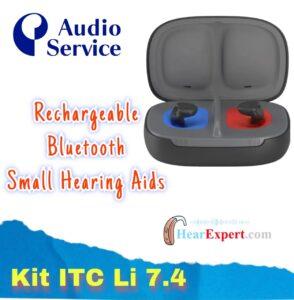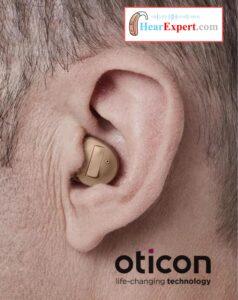In-the-canal (ITC) hearing aids are a popular choice for people who need hearing support but also value discreetness, comfort, and modern features. These hearing aids sit snugly within the ear canal, making them less visible than traditional behind-the-ear models. But they offer more than just an invisible profile — today’s ITC devices are loaded with advanced technology that can enhance your hearing experience in various environments.

If you’re considering buying a pair of ITC hearing aids, it’s important to understand what features matter the most. This guide explores everything you should look for — from sound quality to connectivity — so you can make an informed decision that supports your lifestyle and hearing needs.
1. Personalized Fit and Comfort
Why It Matters:
Since In-the-canal (ITC) hearing aids are custom-molded to fit inside your ear canal, getting the right fit is essential for both comfort and performance. A poorly fitting device can fall out, cause irritation, or fail to deliver optimal sound quality.
What to Look For:
- Custom-molded design based on ear impressions.
- Lightweight and ergonomic shape that doesn’t feel bulky.
- Ventilation ports to reduce occlusion (the “plugged ear” feeling).
- Hypoallergenic materials for sensitive skin.
Pro Tip: Always choose a provider who offers trial fittings and adjustments.
2. Superior Sound Quality
Why It Matters:
At the end of the day, a hearing aid is about hearing better. Good ITC models offer high-definition sound processing to deliver clarity, reduce background noise, and make conversations easier — especially in noisy environments.
What to Look For:
- Digital sound processing (DSP) for natural and precise sound.
- Wide dynamic range compression for better sound balance.
- Noise reduction algorithms to minimize unwanted ambient noise.
- Directional microphones to focus on speech in front of you.
Bonus: Some advanced ITC models even offer environmental adaptation — automatically adjusting settings based on your surroundings.
3. Feedback Cancellation
Why It Matters:
One common issue with hearing aids, especially in-the-canal styles, is the high-pitched whistling sound known as feedback. It can be embarrassing and uncomfortable.
What to Look For:
- Automatic feedback suppression technology.
- Phase inversion techniques that cancel out whistling instantly.
- Adaptive gain controls to reduce the chance of over-amplification.
Look for models that offer real-time feedback management so you don’t have to fiddle with settings manually.

4. Wireless Connectivity and Bluetooth Compatibility
Why It Matters:
Hearing aids have come a long way, and today many are Bluetooth-enabled. This allows you to connect your hearing aid to your smartphone, TV, or even voice assistants. Buy High-Quality Hearing Aids Online from Hear Expert – Trusted by Audiologists, Loved by Ears!
What to Look For:
- Bluetooth streaming for music, calls, and video audio.
- App control for adjusting volume and programs via a smartphone.
- Hands-free calling with built-in microphones.
- Compatibility with both Android and iOS devices.
Some ITC models even work with accessories like TV streamers or remote microphones, which enhance audio clarity when watching TV or talking in noisy rooms.
5. Rechargeable Battery Option
Why It Matters:
Changing tiny batteries every few days can be frustrating — especially for seniors or those with dexterity issues. Rechargeable ITC hearing aids offer convenience and sustainability.
What to Look For:
- Built-in rechargeable batteries with all-day life on a single charge.
- Fast-charging capability (some offer a few hours of use from a 15-minute charge).
- Compact charging cases for portability.
- Battery health monitoring via smartphone apps.
Rechargeable hearing aids are also eco-friendly and can save money in the long run.
6. Noise and Wind Reduction Technology
Why It Matters:
Whether you’re outdoors or in a crowded space, background noise and wind can disrupt your hearing clarity. Advanced ITC hearing aids reduce these distractions effectively.
What to Look For:
- Wind noise management to block outdoor disturbances.
- Speech enhancement filters that prioritize human voices.
- Dynamic range compression for consistent volume in noisy environments.
- Automatic noise classifier that distinguishes between speech and noise.
Some models use machine learning to improve this feature over time based on your listening habits.
7. Tinnitus Masking
Why It Matters:
If you suffer from tinnitus (ringing in the ears), many ITC hearing aids can double as sound therapy devices.
What to Look For:
- Built-in tinnitus relief programs with soothing sounds.
- Customizable masking tones to match your unique tinnitus pitch.
- Combination devices that amplify external sound while reducing internal noise.
You can also find models that work with tinnitus management apps, offering guided exercises and relaxation tools.
8. Automatic Scene Detection
Why It Matters:
You’re not always in the same sound environment — you might be in a quiet room one moment and a noisy restaurant the next. Good ITC hearing aids automatically adjust to suit the situation.

What to Look For:
- Intelligent scene analysis that identifies your current environment.
- Auto-switching programs for music, conversation, outdoors, etc.
- AI-based learning that adapts based on your preferences over time.
This feature saves you from constantly adjusting settings manually.
9. Telecoil (T-Coil) Functionality
Why It Matters:
If you attend public events, use a landline phone, or visit places with hearing loops (like theaters or churches), telecoil functionality can greatly enhance clarity.
What to Look For:
- T-coil compatibility in a compact design.
- Auto-switching to telecoil mode in loop-enabled environments.
- Manual controls to activate telecoil when needed.
Note: Not all ITC hearing aids come with this feature due to size limitations, so check availability if this matters to you.
10. Remote Adjustment and Support
Why It Matters:
Sometimes you may need help adjusting your hearing aid but can’t visit the clinic. With remote care, your audiologist can tweak your device settings from afar.
What to Look For:
- Tele-audiology support with remote fine-tuning.
- In-app feedback tools to report issues.
- Live video or chat support with hearing professionals.
Especially useful for seniors, busy professionals, or those living in remote areas.
11. Discreet Design and Color Options
Why It Matters:
Many people choose ITC aids because they’re practically invisible. If discretion is important to you, check the design options available.

What to Look For:
- Skin-tone color choices for a near-invisible look.
- Low-profile shape that follows your ear canal contours.
- Matte finish to reduce light reflection and visibility.
Some ultra-discreet versions even sit deeper inside the canal and are known as CIC (completely-in-canal) models.
12. Durability and Moisture Protection
Why It Matters:
Your ears are naturally moist, and your hearing aid may be exposed to sweat, humidity, and even dust. Look for a model that can withstand these conditions.
What to Look For:
- IP68 rating for water and dust resistance.
- Protective nano-coating to prevent corrosion.
- Wax guards and ear tip covers to protect internal components.
Durability is especially important if you lead an active lifestyle or live in humid climates.
Conclusion: Choose What Fits You
In-the-canal hearing aids offer a perfect mix of discreetness, modern tech, and personalized performance. But not all devices are made equal — and what works for someone else might not suit your ears or your lifestyle. That’s why understanding the key features — from sound quality and battery life to Bluetooth and tinnitus relief — is so important.
Before buying, consider your priorities:
- Do you need wireless streaming?
- Are you outdoors often?
- Is tinnitus an issue for you?
- Do you want a rechargeable model or are you okay with batteries?
Talk to an audiologist, get your hearing tested, and request a demo if possible. With the right ITC hearing aid, you won’t just hear better — you’ll live better.
